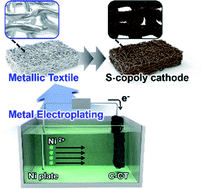High-capacity sulfur copolymer cathode with metallic fibril-based current collector and conductive capping layer†
Abstract
Highly conductive and porous current collectors that can provide favorable interfacial interaction with sulfur components play a critical role in the performance of lithium–sulfur (Li–S) batteries. Although three-dimensional (3D) porous textiles have emerged as promising current collector materials, most reported approaches have reached a limit in producing textiles with metal-like conductivity and do not effectively utilize the large surface area of textiles. Here, we introduce a Li–S copolymer cathode with high areal/specific capacity and good rate capability using a metallic cotton textile (CT)-based current collector that exhibits strong interfacial interaction with sulfur. To fabricate the metallic current collector, CT was first carbonized and subsequently electroplated with nickel (Ni). When a sulfur copolymer-based hybrid slurry and layer-by-layer-assembled conductive capping layer were deposited onto the Ni-electroplated CT, the resulting Li–S copolymer cathode displayed significantly enhanced areal capacity, specific capacity, and rate capability. These improvements were realized due to the full utilization of the large conductive surface area of Ni-electroplated CT as well as the effective chemical confinement of soluble lithium polysulfides by a conductive capping layer. The Li–S copolymer cathode prepared in this study outperforms previously reported sulfur copolymer-based cathodes and provides a basis for the development and design of future high-performance electrodes.



 Please wait while we load your content...
Please wait while we load your content...